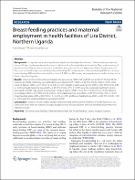Breast‑feeding practices and maternal employment in health facilities of Lira District, Northern Uganda
Abstract
Background: In Uganda, many working mothers stop breast-feeding before the end of the mandatory maternity
leave of 60 days. Inadequate breast-feeding is a risk factor for infant morbidity and mortality. Thus, understanding of
the factors that influence breast-feeding is essential so as to advocate for the appropriate breast-feeding practices.
This cross-sectional study assessed the pre-lacteal feeding (PLF), early initiation of breast-feeding (EIBF) and exclusive
breast-feeding (EBF) and the associated factors for PLF, EIBF and EBF among working mothers in health facilities in Lira
District, Northern Uganda.
Results: Among 376 mothers who participated, the prevalence of PLF, EIBF and EBF was 23.2%, 67.0% and 43.9%,
respectively. Mode of delivery was significantly associated with PLF (AOR = 0.39, 95% CI 0.22–0.68, p < 0.01), while
mode of delivery (AOR = 3.77, 95% CI 2.19–6.47, p < 0.01), length of daily working time (AOR = 0.49, 95% CI 0.29–0.82,
p < 0.01) and paid maternity leave (AOR = 0.45, 95% CI 0.22–0.95, p < 0.05) were the statistically significant factors
associated with EIBF. Age-group, income level, mode of delivery (AOR = 0.26, 95% CI 0.09–0.74, p < 0.05), distance
to workplace (AOR = 0.45, 95% CI 0.26–0.78, p < 0.01), paid maternity leave (AOR = 0.45, 95% CI 0.22–0.95, p < 0.01),
breast-feeding space (AOR = 0.30, 95% CI 0.16–0.59, p < 0.05) and breast-feeding break (AOR = 0.84, 95% CI 0.47–1.50,
p < 0.01) were the significant factors associated with EBF.
Conclusions: Exclusive breast-feeding and pre-lacteal feeding among working mothers in health facilities in Lira
District are lower than the national averages, but prevalence of early initiation of breast-feeding is higher than the
national average.

